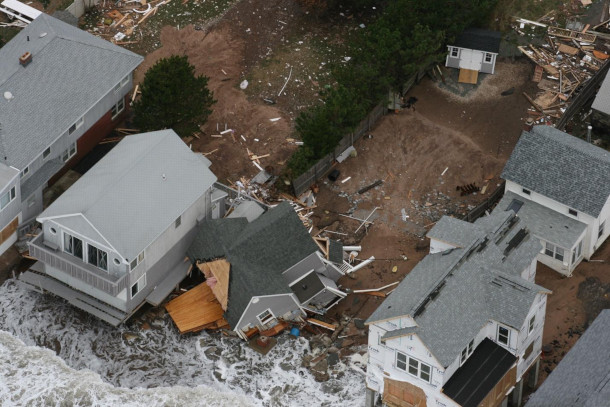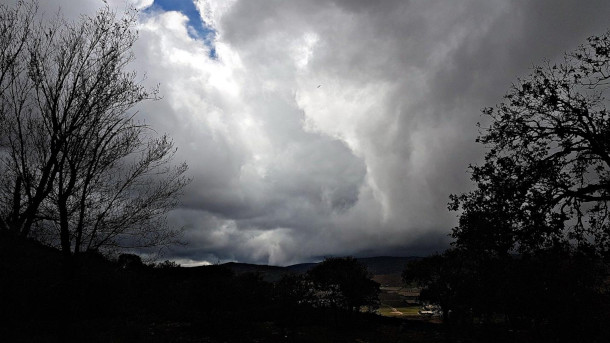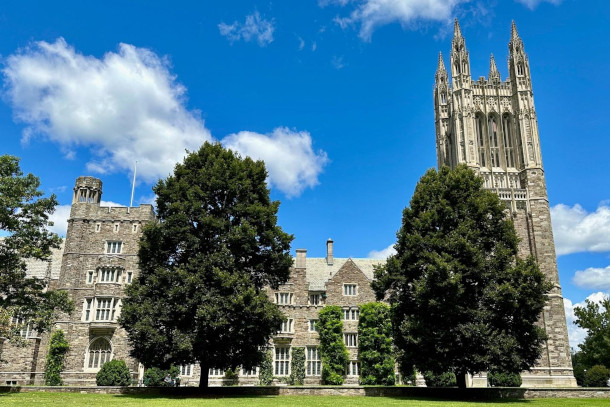NOAA Climate Science Cuts
Air Date: Week of May 2, 2025

Experts worry that funding cuts to NOAA will undermine our ability to predict hurricanes, leading to more lives lost. (Photo: Dannel Malloy, Wikimedia Commons, CC BY 2.0)
A key climate modeling program within the National Oceanic and Atmospheric Administration or NOAA is slated for near-elimination, according to a draft White House memo. Abrahm Lustgarten investigated these planned cuts for ProPublica and discusses with Host Jenni Doering the potential impacts to weather forecasting, disaster preparedness, agriculture, military operations and more.
Transcript
BELTRAN: It’s Living on Earth, I’m Paloma Beltran
DOERING: And I’m Jenni Doering
It is not an easy time to be a climate scientist. The Trump administration is slashing research funds. And on April 28th hundreds of scientists were dismissed from their work on the National Climate Assessment due in 2028. Every four to five years this report projects domestic climate impacts to help guide decisions about preparing for rising seas, extreme heat, stronger hurricanes and more. It is unclear how the Trump Administration plans to complete the sixth assessment, which is required by Congress. And the climate modeling that underpins reports like the National Climate Assessment is itself a target of the Trump Administration. Here to speak to us about proposed cuts to climate research at the National Oceanic and Atmospheric Administration is journalist Abrahm Lustgarten. Hi Abrahm, Welcome back to Living on Earth!
LUSTGARTEN: Hi there. Thanks for having me.
DOERING: So, you wrote an article for ProPublica about federal funding cuts to NOAA, the National Oceanic and Atmospheric Administration. What is the extent of these cuts?
LUSTGARTEN: The proposed cuts for NOAA, which come from a leaked document from the Office of Management and Budget, essentially proposed to decimate the agency as we know it. They're not total, they would preserve certain functions. They say that they want to prioritize and preserve the National Weather Service and the kind of weather forecasts that we're all used to getting, for example. And there are other programs within NOAA that will survive or struggle on, but the Office of Atmospheric Research, which is NOAA's primary science division that focuses on climate change, especially is slated for about 74% cuts, and the memo describes that as basically the elimination of that office of the agency, even though there's some funding left. And overall, the agency would face about 27% cut. It would lose a couple billion dollars, and this will affect everything from the data that it collects and how it disseminates that data to the public, and even the graphics teams that it has available to make pretty websites, to make their information understandable, and the satellites they put up in space, and really all sorts of scientific work that NOAA does.

Though it is unlikely that weather forecasts would immediately become inaccurate, experts worry that cuts to NOAA would disrupt the organization’s climate models and make it more difficult to predict the changing weather as climate disruption intensifies. (Photo: Mennal, Wikimedia Commons, CC BY-SA 4.0)
DOERING: That's quite a huge cut for an agency that has a pretty important role in climate modeling and climate science.
LUSTGARTEN: Yeah, so this is the office that really invented climate modeling, in a way. It has a really interesting history. It goes back to 1955. It developed some of this first earth systems modeling and really early examination of both the planet's oceans and its atmosphere, in a way that makes it possible to not only have great weather forecasts, but to understand what's happening on the planet as a whole. There are other places, other labs, that do this now in a sophisticated way, but this department is the best and is the most sophisticated, and creates an extraordinary amount of information that really affects our lives in every way.
DOERING: And in your article, you talk about a specific laboratory that is doing a lot of this research. What makes this particular laboratory so important for climate change research?
LUSTGARTEN: Yeah, so the Office of Atmospheric Research at NOAA works in part by having what they call these cooperative agreements with universities across the country, and by far the most important of them is an old collaboration at Princeton University, where they run the Geophysical Fluid Dynamics Laboratory, which is known as GFDL. And this is really the nerve center of NOAA's climate modeling. It is the place where they cooperatively developed this model, going back over generations, and it's a place where they run this model now as well. So, this is the place that figures out the architecture of modeling that NOAA then uses for all its different departments. And even other agencies, like NASA, borrow parts of this model, and they become like the foundation of our national weather system modeling, for example, or our national hurricane prediction and things like that.
DOERING: So of course, we're talking about the impacts to climate science climate modeling, but you're mentioning that, you know, like forecasting is involved here as well. I mean, this model is foundational for the weather forecasts that NOAA contributes to. So if some of these forecasting capabilities are curtailed or eliminated, what could be the impact on daily forecasts that we check on our phones?
LUSTGARTEN: Well, in terms of daily forecasts, I mean, I think we take for granted how good those forecasts are and how readily available information is about whether it's going to rain at 12 pm and stop at 12:15 or if it's just going to rain sometime on Sunday. That level of detail is the kind of thing that these models make possible, and it's really difficult to know what's going to happen if these cuts are enacted. It could be that the models and the lab are shut down entirely, and what they do becomes inaccessible to the public and becomes inaccessible to NOAA entirely, and that would be a really severe move, and it's hard to know how that would affect our weather forecast. The people that I talked to say that it's much more likely that their progress essentially gets frozen in place. So right now, the national weather system, National Weather Center, has taken its version of those models, and it creates our forecasts every day, and it will cease to update those models, and so the forecasts will remain as good as they are now, but not get much better. And what will happen is the earth continues to change, and we're seeing climate change, for example, really change the norms that we're accustomed to. Over time, those weather forecasts will lose the ability to understand what's happening, and they will become less accurate, and eventually they would become mismatched with what's actually happening.
DOERING: What might happen to predictions of hurricanes and other natural disasters if these funding cuts are implemented?

Proposed funding cuts to NOAA, discovered in a leaked memo from the White House Office of Management and Budget, would severely restrict a long-standing climate research partnership with Princeton University. (Photo: Zeete, Wikimedia Commons, CC BY-SA 4.0)
LUSTGARTEN: Well, they'll get increasingly less precise. Every May, for example, the GFDL lab at Princeton delivers an updated hurricane model to the National Hurricane Center. And the Hurricane Center puts out, famously, every May before the start of hurricane season, an updated prediction for how many storms we're going to get and where and why, and it's based off of things like the most recent readings, which NOAA has collected, of currents in the Atlantic Ocean and the temperatures in the Atlantic Ocean. And so, if we don't have an accurate forecast, we’ll be blindsided by the storms that will inevitably come, and the less warning we have, the greater the impact, and the greater you know, the destruction and the danger to the people that live in the places that they strike will be.
DOERING: So, NOAA is part of the Department of Commerce. What are the economic implications of limiting NOAA's capabilities. Can you talk about the connection between NOAA's work and the American economy?
LUSTGARTEN: I think that's the most surprising thing about this story. Americans tend to think of NOAA is an obscure science agency that maybe does important work, but it's off there in a niche on the side somewhere, and they don't realize that NOAA is deeply embedded in almost every aspect of our economy, our national security, our defense systems, right down to how our local communities or governments make decisions about planning or zoning. And it's ingrained in these ways because it produces an extraordinary amount of data. And so, this data is used, for example, by the shipping industry to not only chart what direction its tankers go in, but how they'll save fuel in doing that and avoid a big hurricane. Farmers and agricultural industry folks use not only the forecast to determine what their planting plan will be and their timing, but what kind of insurance that they'll get to protect their crops. It's a part of everything from local zoning and infrastructure planning in communities to farming and shipping and logistics and airplanes flying and just about everything else.
DOERING: Yeah, I mean, just to highlight one figure from your article, you wrote that NOAA's chief economists estimate that the agency's El Nino outlooks alone boost the U.S. agricultural economy by like, $300 million a year, and corn growers save $4 billion in fertilizer and cleanup costs. That's quite a huge number.
LUSTGARTEN: Yeah, that's right, and then that's because there's some little window into NOAA data that those farmers will use to understand when is the best time to apply fertilizer, for example, so that it doesn't just get washed away by the next rainstorm, or so that the soil is most able to absorb it. These are really like technical, pun intended, down in the weeds, kind of questions, but they're fundamental to how that industry works.

Without forecasts from NOAA, the United States military might have to depend on other countries for weather predictions, potentially undermining our national security. (Photo: United States Air Force, Wikimedia Commons, public domain)
DOERING: And how does the military use this data from NOAA, and what might be the impacts if that disappears?
LUSTGARTEN: You know, there's some ways in which NOAA data seems to affect national security issues. One is operational planning. The U.S. military has its own weather forecast system and staff, but it bases a lot of that on those same NOAA models, and with a lot of NOAA input. And so, you know, imagine you're going to send the Air Force on a strike mission, you want to know what the weather is that they're flying into, you want to know if there's an advantageous break in cloud cover. So these are the kind of strategic advantages that our really superior understanding of weather science makes possible for the U.S. military.
DOERING: How do you think other countries will respond, Abrahm, if the cuts to NOAA are enacted?
LUSTGARTEN: Well, in the short term, they will compensate. I mean, there's really good science, and scientists and models being developed in Europe, for example, in Japan. They're very capable. They will continue to do their climate work, and it will be pretty good work. The experts that I talk to point out, though, that many of the scientists leading those efforts around the world were trained at this GFDL lab in Princeton. There's a knowledge cultivation that U.S. universities have led, which NOAA has always been a big part of, and that's created and supported the science culture of research around climate science around the world. And so that begins to be undermined both the reputation and the functionality of it. And so you can see a future where in the long term, those scientists aren't as knowledgeable. Their systems aren't as well tested. They never got the immense support of billions of dollars that the U.S. government has poured into this research for a long time. And so long term, those programs could falter, or they could be invested in by Europe, for example, and they could be great, but we won't have them. And that's the other real risk that a lot of the folks that I talked to point to, which is that not necessarily that the world will lose its understanding of climate change, but that the United States will. And, in losing that, we become dependent on others. Imagine if our Air Force wants to carry out an operation in the Middle East and has to check with the Australian government first to get a good forecast. And imagine if that foreign government doesn't want to cooperate. You know, it's another link in the chain that just undercuts our ability to operate independently, and in a very strong way.

Farmers depend on NOAA’s forecasts to know when to apply fertilizer and plant crops. (Photo: Mark Stebnicki, Pexels, Pexels license)
DOERING: So as we're speaking, you know, I understand that these cuts at NOAA to climate modeling are not yet set in stone. But what do we know about the timing here and about any pushback from Congress?
LUSTGARTEN: Yeah, so we know very little, unfortunately. I got no response in my reporting from either officially, from NOAA, from the Department of Commerce, from the White House, or the Office of Management and Budget. In that leaked memo from the Office of Management and Budget, the agencies were given a deadline of April 24 to present plans for how they were shifting their operations or changing their staff and their programs to comply with this memo. So we don't know exactly if those numbers will be approved, but it seems pretty clear that NOAA and the rest of the Department of Commerce have their marching orders to begin making this change.
DOERING: Abrahm Lustgarten is an editor covering climate at ProPublica. Thank you so much, Abrahm.
LUSTGARTEN: Thanks for having me.
DOERING: We reached out to the White House for comment but did not receive a response in time for this broadcast.
Links
Read Lustgarten’s full story about the cuts to NOAA.
Learn about the Geophysical Fluid Dynamics Laboratory at Princeton University.
Living on Earth wants to hear from you!
Living on Earth
62 Calef Highway, Suite 212
Lee, NH 03861
Telephone: 617-287-4121
E-mail: comments@loe.org
Newsletter [Click here]
Donate to Living on Earth!
Living on Earth is an independent media program and relies entirely on contributions from listeners and institutions supporting public service. Please donate now to preserve an independent environmental voice.
NewsletterLiving on Earth offers a weekly delivery of the show's rundown to your mailbox. Sign up for our newsletter today!
 Sailors For The Sea: Be the change you want to sea.
Sailors For The Sea: Be the change you want to sea.
 The Grantham Foundation for the Protection of the Environment: Committed to protecting and improving the health of the global environment.
The Grantham Foundation for the Protection of the Environment: Committed to protecting and improving the health of the global environment.
 Contribute to Living on Earth and receive, as our gift to you, an archival print of one of Mark Seth Lender's extraordinary wildlife photographs. Follow the link to see Mark's current collection of photographs.
Contribute to Living on Earth and receive, as our gift to you, an archival print of one of Mark Seth Lender's extraordinary wildlife photographs. Follow the link to see Mark's current collection of photographs.
 Buy a signed copy of Mark Seth Lender's book Smeagull the Seagull & support Living on Earth
Buy a signed copy of Mark Seth Lender's book Smeagull the Seagull & support Living on Earth

